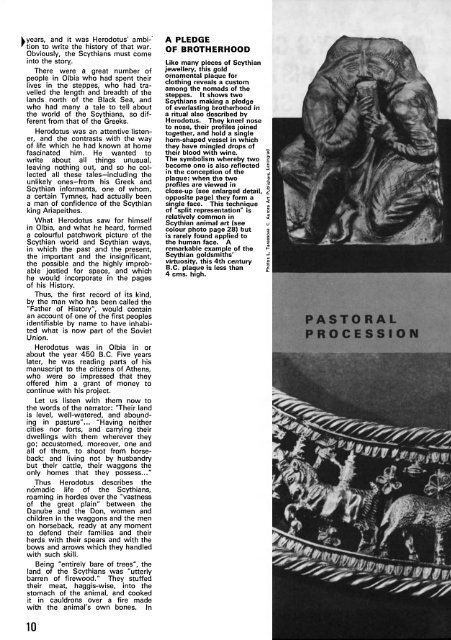The Scythians: nomad goldsmiths of the open steppes; The ...
The Scythians: nomad goldsmiths of the open steppes; The ...
The Scythians: nomad goldsmiths of the open steppes; The ...
You also want an ePaper? Increase the reach of your titles
YUMPU automatically turns print PDFs into web optimized ePapers that Google loves.
L years, and it was Herodotus' ambi-'<br />
' tion to write <strong>the</strong> history <strong>of</strong> that war.<br />
Obviously, <strong>the</strong> <strong>Scythians</strong> must come<br />
into <strong>the</strong> story.<br />
<strong>The</strong>re were a great number <strong>of</strong><br />
people in Olbia who had spent <strong>the</strong>ir<br />
lives in <strong>the</strong> <strong>steppes</strong>, who had tra¬<br />
velled <strong>the</strong> length and breadth <strong>of</strong> <strong>the</strong><br />
lands north <strong>of</strong> <strong>the</strong> Black Sea, and<br />
who had many a tale to tell about<br />
<strong>the</strong> world <strong>of</strong> <strong>the</strong> <strong>Scythians</strong>, so dif¬<br />
ferent from that <strong>of</strong> <strong>the</strong> Greeks.<br />
Herodotus was an attentive listen¬<br />
er, and <strong>the</strong> contrasts with <strong>the</strong> way<br />
<strong>of</strong> life which he had known at home<br />
fascinated him. He wanted to<br />
write about all things unusual,<br />
leaving nothing out, and so he col¬<br />
lected all <strong>the</strong>se talesincluding <strong>the</strong><br />
unlikely onesfrom his Greek and<br />
Scythian informants, one <strong>of</strong> whom,<br />
a certain Tymnes, had actually been<br />
a man <strong>of</strong> confidence <strong>of</strong> <strong>the</strong> Scythian<br />
king Ariapei<strong>the</strong>s.<br />
What Herodotus saw for himself<br />
in Olbia, and what he heard, formed<br />
a colourful patchwork picture <strong>of</strong> <strong>the</strong><br />
Scythian world and Scythian ways,<br />
in which <strong>the</strong> past and <strong>the</strong> present,<br />
<strong>the</strong> important and <strong>the</strong> insignificant,<br />
<strong>the</strong> possible and <strong>the</strong> highly improb¬<br />
able jostled for space, and which<br />
he would incorporate in <strong>the</strong> pages<br />
<strong>of</strong> his History.<br />
Thus, <strong>the</strong> first record <strong>of</strong> its kind,<br />
by <strong>the</strong> man who has been called <strong>the</strong><br />
"Fa<strong>the</strong>r <strong>of</strong> History", would contain<br />
an account <strong>of</strong> one <strong>of</strong> <strong>the</strong> first peoples<br />
identifiable by name to have inhabi¬<br />
ted what is now part <strong>of</strong> <strong>the</strong> Soviet<br />
Union.<br />
Herodotus was in Olbia in or<br />
about <strong>the</strong> year 450 B.C. Five years<br />
later, he was reading parts <strong>of</strong> his<br />
manuscript to <strong>the</strong> citizens <strong>of</strong> A<strong>the</strong>ns,<br />
who were so impressed that <strong>the</strong>y<br />
<strong>of</strong>fered him a grant <strong>of</strong> money to<br />
continue with his project.<br />
Let us listen with <strong>the</strong>m now to<br />
<strong>the</strong> words <strong>of</strong> <strong>the</strong> narrator: "<strong>The</strong>ir land<br />
is level, well-watered, and abound¬<br />
ing in pasture"... "Having nei<strong>the</strong>r<br />
cities nor forts, and carrying <strong>the</strong>ir<br />
dwellings with <strong>the</strong>m wherever <strong>the</strong>y<br />
go; accustomed, moreover, one and<br />
all <strong>of</strong> <strong>the</strong>m, to shoot from horse¬<br />
back; and living not by husbandry<br />
but <strong>the</strong>ir cattle, <strong>the</strong>ir waggons <strong>the</strong><br />
only homes that <strong>the</strong>y possess..."<br />
Thus Herodotus describes <strong>the</strong><br />
<strong>nomad</strong>ic life <strong>of</strong> <strong>the</strong> <strong>Scythians</strong>,<br />
roaming in hordes over <strong>the</strong> "vastness<br />
<strong>of</strong> <strong>the</strong> great plain" between <strong>the</strong><br />
Danube and <strong>the</strong> Don, women and<br />
children in <strong>the</strong> waggons and <strong>the</strong> men<br />
on horseback, ready at any moment<br />
to defend <strong>the</strong>ir families and <strong>the</strong>ir<br />
herds with <strong>the</strong>ir spears and with <strong>the</strong><br />
bows and arrows which <strong>the</strong>y handled<br />
with such skill.<br />
Being "entirely bare <strong>of</strong> trees", <strong>the</strong><br />
land <strong>of</strong> <strong>the</strong> <strong>Scythians</strong> was "utterly<br />
barren <strong>of</strong> firewood." <strong>The</strong>y stuffed<br />
<strong>the</strong>ir meat, haggis-wise, into <strong>the</strong><br />
stomach <strong>of</strong> <strong>the</strong> animal, and cooked<br />
it in cauldrons over a fire made<br />
with <strong>the</strong> animal's own bones. In<br />
10<br />
A PLEDGE<br />
OF BROTHERHOOD<br />
Like many pieces <strong>of</strong> Scythian<br />
jewellery, this gold<br />
ornamental plaque for<br />
clothing reveals a custom<br />
among <strong>the</strong> <strong>nomad</strong>s <strong>of</strong> <strong>the</strong><br />
<strong>steppes</strong>. It shows two<br />
<strong>Scythians</strong> making a pledge<br />
<strong>of</strong> everlasting bro<strong>the</strong>rhood in<br />
a ritual also described by<br />
Herodotus. <strong>The</strong>y kneel nose<br />
to nose, <strong>the</strong>ir pr<strong>of</strong>iles joined<br />
toge<strong>the</strong>r, and hold a single<br />
horn-shaped vessel in which<br />
<strong>the</strong>y have mingled drops <strong>of</strong><br />
<strong>the</strong>ir blood with wine.<br />
<strong>The</strong> symbolism whereby two<br />
become one is also reflected<br />
in <strong>the</strong> conception <strong>of</strong> <strong>the</strong><br />
plaque: when <strong>the</strong> two<br />
pr<strong>of</strong>iles are viewed in<br />
close-up (see enlarged detail,<br />
opposite page) .<strong>the</strong>y form a<br />
single face. This technique<br />
<strong>of</strong> "split representation" is<br />
relatively common in<br />
Scythian animal art (see<br />
colour photo page 28) but<br />
is rarely found applied to<br />
<strong>the</strong> human face. A<br />
remarkable example <strong>of</strong> <strong>the</strong><br />
Scythian <strong>goldsmiths</strong>'<br />
virtuosity, this 4th century<br />
B.C. plaque is less than<br />
4 cms. high.

















